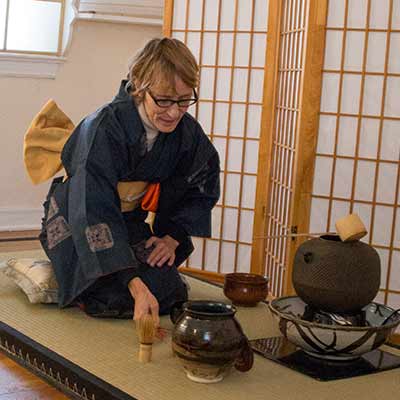
Most of my friends and family know that I am very interested in Japanese culture. Simplicity, a devotion to beauty, being in tune with nature, and attention to detail in almost everything the Japanese do are all aspects I find very appealing. When I found myself faced with the opportunity to learn Japanese Tea Ceremony I jumped at the chance. Of course I didn't really understand or know much about it. I just thought, "It's Japanese, so I'll probably like it." But to be honest, at first I didn't really get it. I was learning the mechanics of it, but I hadn't even begun to scratch the surface of what it really meant to practice tea ceremony.
I persisted at first merely because I came to love my friend Maggie, who was both teacher and student with me. It was time we spent in each other's company, and although we didn't always agree, we always knew that somehow we needed to be doing tea together. As time passed and for purely practical reasons I became intent on having a dedicated tea space... a tea house. And so with some finegling and hard work a space was secured and created complete with Japanese tatami mat, homemade shoji screen in the window and an almost tokonoma, an area for the tea scroll. Not exactly a traditional tea house, but not bad considering we had almost no money and we were a long way from Japan.
Then I was asked to answer questions at a tea ceremony that another host was giving. I realized that even though I had been learning how to do the ceremony, I really didn't know that much about it. And so I started to research more, learn more and understand more. I read what I could find in english about the history of tea ceremony, the layers of Japanese society that practiced tea and information about the tea itself. Matcha green tea... not your ordinary brewed cup of dirty water. Instead a bright and vibrant green soup, slighty bitter and earthy and incredibly uplifting. No wonder the Japanese fell in love with it. You feel great after drinking it, and in the days before coffee, cocaine, and Red Bull, matcha green tea would have been the popular choice for a bit of a boost. Going into battle? Drink some tea. Staying up all night meditating in a Zen monestary? Drink some tea. Need to impress and uplift the local magistrate who can pull some strings for you? Serve him some tea.
The months went by and the tea house was finally ready to host guests. Why is a tea house such a big deal? I didn't even know when I started the project what it really meant. But after our first ceremony in the "space", it all made sense. Imagine going about your busy and problem filled day. Now you are invited to tea and so you arrive at the tea house, entering first through a garden, an intermediate space. A space that says you are leaving the outside world. You wait with the other guests in the garden... a moment to contemplate and release. You ritually purify by washing your hands and mouth in a tsukubai, you remove your shoes and enter the tea house. Inside it is quiet, the light is somewhat dim and the decor is minimal. In fact, the only items in the space are a beautiful scroll and a humble flower arrangement called a chabana. You hear the simmering of the water in the kettle and you contemplate the concept of ichi-go ichi-e.
What is Ichi-go Ichi-e? It basically means this moment is unique and thus should be treasured. It speaks of the practice of being completely in the moment. This moment will never come again, and so you embrace it and embody it. The other guests, the time of day, the special sweet served before the tea, the type of matcha being served, the choosing of the scroll and the flower. It all comes together to create this moment, this one time.
Now that the guests have entered the tea house, the host is ready and the tea ceremony begins. Each movement, each utensil, each and every detail considered and executed for a reason. There is no chit chat, nothing extraneous, nothing meaningless or unnesseccary. What happens next? The host serves tea. Now making tea is something that the Japanese did all the time every day. A simple daily task that many would not bring much presence of mind to doing. But what happens when you take a simple daily task and elevate it? When you practice tea ceremony, you practice bringing tranquility, respect, purity and harmony to something simple and ordinary. Pretty soon you realize that you can elevate any activity by being present, aware and mindful.
This of course just scratches the surface of tea ceremony. I was told recently that in Japan, a person who has studied tea for ten years is considered a beginner. As my practice deepens and my experiences of sharing tea increase, I imagine that new understandings will unfold. I like to think that enlightenment can be found in a bowl of tea. The true master of tea becomes the master of all.